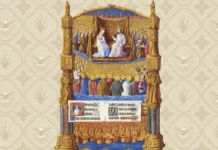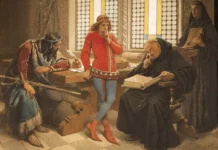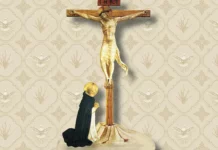All the faithful should be aware that to participate in the Eucharistic Sacrifice is their chief duty and supreme dignity, with such earnestness and concentration that they may be united as closely as possible with the High Priest.
The mystery of the most Holy Eucharist which Christ, the High Priest instituted, and which He commands to be continually renewed in the Church by His ministers, is the culmination and centre, as it were, of the Christian religion. We consider it opportune in speaking about the crowning act of the Sacred Liturgy, to delay for a little while and call your attention, Venerable Brethren, to this most important subject. […]
True and proper sacrifice
The august Sacrifice of the Altar, then, is no mere empty commemoration of the Passion and Death of Jesus Christ, but a true and proper act of sacrifice, whereby the High Priest by an unbloody immolation offers himself a most acceptable Victim to the Eternal Father, as He did upon the Cross. […]
The Priest is the same, Jesus Christ, whose sacred Person His minister represents. Now the minister, by reason of the sacerdotal consecration which he has received, is made like to the High Priest and possesses the power of performing actions in virtue of Christ’s very person. Wherefore in his priestly activity he in a certain manner “lends his tongue, and gives his hand” to Christ.[1]
Likewise the Victim is the same, namely, our divine Redeemer in His human nature with His true Body and Blood. The manner, however, in which Christ is offered is different.
On the Cross He completely offered himself and all His sufferings to God, and the immolation of the Victim was brought about by the bloody death, which He underwent of His free will. But on the Altar, by reason of the glorified state of His human nature, “death shall have no more dominion over Him” (Rom 6:9), and so the shedding of His Blood is impossible; still, according to the plan of divine wisdom, the sacrifice of our Redeemer is shown forth in an admirable manner by external signs which are the symbols of His death.
For by the “transubstantiation” of bread into the Body of Christ and of wine into His Blood, His Body and Blood are both really present: now the Eucharistic Species under which He is present symbolize the actual separation of His Body and Blood. Thus the commemorative representation of His death, which actually took place on Calvary, is repeated in every Sacrifice of the Altar, seeing that Jesus Christ is symbolically shown by separate symbols to be in a state of victimhood.
Praise, expiation, impetration and thanksgiving
Moreover, the appointed ends are the same. The first of these is to give glory to the Heavenly Father. From His birth to His death, Jesus Christ burned with zeal for the divine glory; and the offering of His Blood upon the Cross rose to Heaven in an odour of sweetness. To perpetuate this praise, the members of the Mystical Body are united with their divine Head in the Eucharistic Sacrifice, and with Him, together with the Angels and Archangels, they sing immortal praise to God and give all honour and glory to the Father Almighty.
The second end is duly to give thanks to God. Only the divine Redeemer, as the eternal Father’s most beloved Son whose immense love He knew, could offer Him a worthy return of gratitude. This was His intention and desire at the Last Supper when He “gave thanks.” He did not cease to do so when hanging upon the Cross, nor does He fail to do so in the august Sacrifice of the Altar, which is an act of thanksgiving or a “Eucharistic” act; since this “is truly meet and just, right and availing unto salvation.”2
The third end proposed is that of expiation, propitiation and reconciliation. Certainly, no one was better fitted to make satisfaction to Almighty God for all the sins of men than was Christ. Therefore, He desired to be immolated upon the Cross “as a propitiation for our sins, not for ours only but also for those of the whole world” (1 Jn 2:2) and likewise He daily offers Himself upon our altars for our redemption, that we may be rescued from eternal damnation and admitted into the company of the elect. This He does, not for us only who are in this mortal life, but also “for all who rest in Christ, who have gone before us with the sign of Faith and repose in the sleep of peace;”3 for whether we live, or whether we die “still we are not separated from the one and only Christ.”4
The fourth end, finally, is that of impetration. Man, being the prodigal son, has made bad use of and dissipated the goods which he received from his heavenly Father. Accordingly, he has been reduced to the utmost poverty and to extreme degradation. However, Christ on the Cross, “offering prayers and supplications with a loud cry and tears […], has been heard for His reverence” (Heb 5:7). Likewise upon the altar He is our mediator with God in the same efficacious manner, so that we may be filled with every blessing and grace. […]
Salvation flows from the Head to the members
In a certain sense, it can be said that on Calvary Christ built a font of purification and salvation which He filled with the Blood He shed; but if men do not bathe in it and there wash away the stains of their iniquities, they can never be purified and saved.
The cooperation of the faithful is required so that sinners may be individually purified in the Blood of the Lamb. For although, speaking generally, Christ reconciled by His painful death the whole human race with the Father, He wished that all should approach and be drawn to His Cross, especially by means of the Sacraments and the Eucharistic Sacrifice, to obtain the salutary fruits produced by Him upon it.
Through this active and individual participation, the members of the Mystical Body not only become daily more like to their divine Head, but the life flowing from the Head is imparted to the members, so that we can each repeat the words of St. Paul, “With Christ I am nailed to the Cross: I live, now not I, but Christ liveth in me” (Gal 2:19-20).
We have already explained sufficiently and of set purpose on another occasion, that Jesus Christ when dying on the Cross, bestowed upon His Church, as a completely gratuitous gift, the immense treasure of the Redemption. But when it is a question of distributing this treasure, He not only commits the work of sanctification to His Immaculate Spouse, but also wishes that, to a certain extent, sanctity should derive from her activity.
There may be no cessation of our hymn of praise and thanksgiving
The august Sacrifice of the Altar is, as it were, the supreme instrument whereby the merits won by the divine Redeemer upon the cross are distributed to the faithful: “as often as this commemorative sacrifice is offered, there is wrought the work of our Redemption.”5
This, however, so far from lessening the dignity of the actual sacrifice on Calvary, rather proclaims and renders more manifest its greatness and its necessity, as the Council of Trent declares.6 Its daily immolation reminds us that there is no salvation except in the Cross of Our Lord Jesus Christ (cf. Gal 6:14) and that God himself wishes that there should be a continuation of this sacrifice “from the rising of the sun till the going down thereof” (Mal 1:11), so that there may be no cessation of the hymn of praise and thanksgiving which man owes to God, seeing that he required His help continually and has need of the Blood of the Redeemer to remit sin which challenges God’s justice.
It is, therefore, desirable, Venerable Brethren, that all the faithful should be aware that to participate in the Eucharistic Sacrifice is their chief duty and supreme dignity, and that not in an inert and negligent fashion, giving way to distractions and day-dreaming, but with such earnestness and concentration that they may be united as closely as possible with the High Priest, according to the Apostle, “Let this mind be in you which was also in Christ Jesus” (Phil 2:5). And together with Him and through Him let them make their oblation, and in union with Him let them offer up themselves.
Excerpts from: PIUS XII. Mediator Dei, 20/11/1947
Notas
1 ST. JOHN CHRYSOSTOM. In Ioannem. Homily LXXXVI, n.4.
2 ROMAN MISSAL. Preface.
3 ROMAN MISSAL. Canon of the Mass.
4 ST. AUGUSTINE. De Trinitate. L.XIII, c.19.
5 ROMAN MISSAL. Secret of the Ninth Sunday after Pentecost.
6 Cf. COUNCIL OF TRENT. Session XXII, c.2 and can.4.







